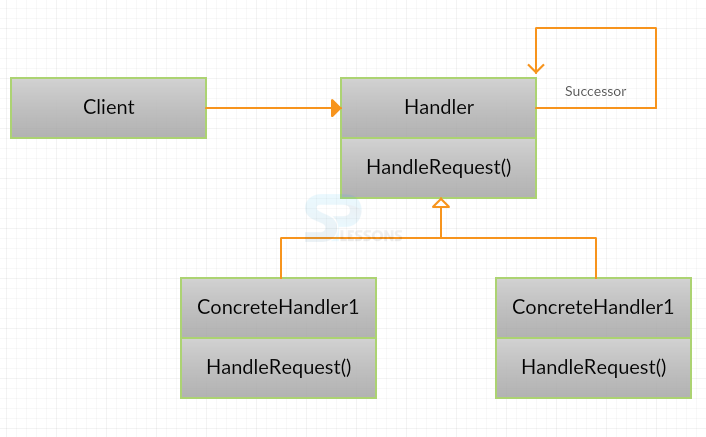 Description
Description
Chain Of Responsibilities Pattern is a Behavioral Pattern mainly used to decouple the requests. The request from the client is passed through a set of objects that decide whether to send the request to the next object or not.
Each object contains the reference of another object. If a object cannot process the request, then it is transferred to the next object and forms a chain structure. An object oriented link is formed in the pattern.
 Advantages
Advantages
- Loose coupling can be done easily.
- Chain of responsibilities pattern can be used as command.
- The handler object is not revealed.
- The request is handled automatically.
- Each object in the chain will have its own implementation.
 Conceptual
figure
Conceptual
figure
 Examples
Examples
Following is an example for Chain Of Responsibility Pattern, Create an interface Chain
[java] public interface Chain
{
public abstract void setNext(Chain nextInChain);
public abstract void process(Number request);
} [/java]
Creating a class Value which will request the object.
[java]
public class Value
{
private int value;
public Number(int value)//reads the value
{
this.value = value;
}
public int getValue()//returns the value
{
return value;
}
}
[/java]
Chain Of Responsibility Pattern - In chain series, this class is a link. Creating a class NegativeValue to implement the interface Chain
[java]
public class NegativeValue implements Chain
{
private Chain nextInChain;
public void setNext(Chain c) // overrides the interface method
{
nextInChain = c;
}
public void process(Value request)//overrides the interface method
{
if (request.getValues() < 0)
{
System.out.println("NegativeValue : " + request.getValue());
}
else
{
nextInChain.process(request);
}
}
}[/java]
Chain Of Responsibility Pattern - Creating a class ZeroValue to implement the interface Chain and this class acts as another link in the chain.
[java]public class ZeroValue implements Chain
{
private Chain nextInChain;
public void setNext(Chain c)//overrides the interface method
{
nextInChain = c;
}
public void process(Value request)//overrides the interface method
{
if (request.getValue() == 0) {
System.out.println("ZeroValue : " + request.getValue());
}
else
{
nextInChain.process(request);
}
}
}
[/java]
Creating a class PositiveProcessor to implement the interface Chain and this class acts as another link to the chain.
[java]
public class PositiveProcessor implements Chain
{
private Chain nextInChain;
public void setNext(Chain c)//overrides the interface method
{
nextInChain = c;
}
public void process(Number request)//overrides the interface method
{
if (request.getNumber() > 0)
{
System.out.println("PositiveProcessor : " + request.getNumber());
}
else {
nextInChain.process(request);
}
}
}[/java]
Chain Of Responsibility Pattern - Creating a main class Chain and configuration of chain is done.
[java]
public class ChainTest
{
public static void main(String[] args)
{
//configure Chain of Responsibility
Chain c1 = new NegativeValue();
Chain c2 = new ZeroValue();
Chain c3 = new PositiveValue();
c1.setNext(c2);
c2.setNext(c3);
//calling chain of responsibility
c1.process(new Value(90));
c1.process(new Value(-40));
c1.process(new Value(0));
c1.process(new Value(1000));
}
}[/java]
 Output
Output
The result will be as follows.
[java]PositiveValue : 90
NegativeValue : -40
ZeroValue : 0
PositiveValue : 1000
[/java]
 Key Points
Key Points
- Decoupling of requests can be done easily.
- Using Chain of responsibilities, request can be passed between the objects easily.
- User will not know which process is processing the request.




